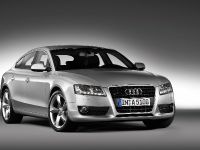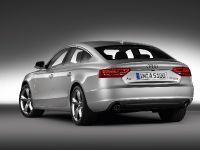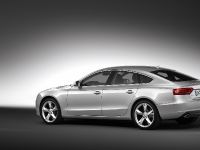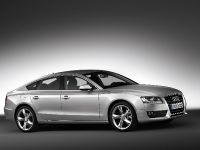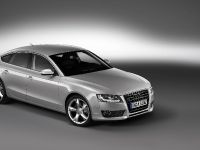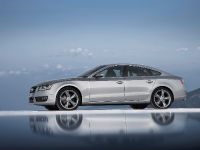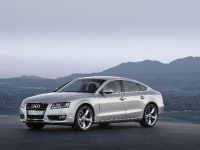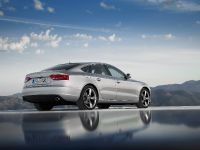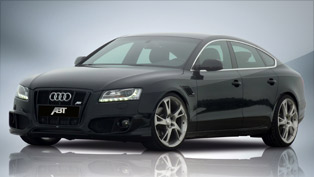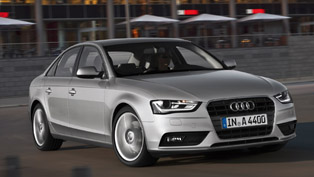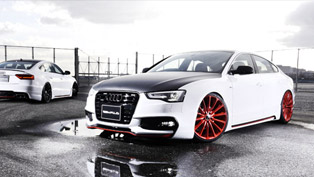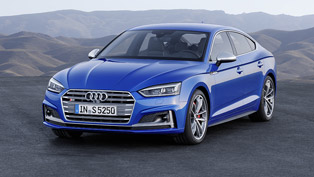Audi A5 Sportback
Audi is presenting a new vehicle concept – the Audi A5 Sportback. The five-door model with the long, flowing rear end unites the best of various vehicle genres: the emotion and elegance of a coupe, the comfort of a sedan and the practicality of a station wagon. The Sportback joins the Coupé and Cabriolet as the third member of the A5 model family.
The A5 Sportback will be rolling into Audi dealerships in September featuring an emotion-packed design, high everyday practicality, a sporty character and engines that are as efficient as they are powerful. Sales have already begun, with prices starting at 33,650 euros. A further, specially-priced model to follow in 2010 will make the A5 Sportback the entry-level model in the A5 model series.
Audi, the inventor of the Avant, is setting new trends in design with the A5 Sportback. The five-door coupe is defined by elegant lines. It is 36 millimeters (1.42 in) lower than the A4 Sedan; with its short front overhang, long wheelbase, wide track and the four frameless doors with their slender window lines, it is the very picture of sporty elegance.
The interior is spacious, offering uncompromising comfort in all four seats. The large luggage compartment hatch is harmoniously integrated into the long, tapered tail end with the flat C pillars; the spoiler lip underscores the tension-filled character. The luggage compartment volume of 480 liters (16.95 cu ft) nearly matches that of the A4 Avant and increases to 980 liters (34.61 cu ft) with the rear seats folded down.
The A5 Sportback follows the consistent path of innovative technologies at Audi when it comes to the drivetrain. All of the engines are highly-efficient direct injection models – TDI for the cultivated diesels, FSI for the gasoline engines – and all comply with the Euro 5 emissions standard. All models are equipped with a recuperation system that recovers energy during braking and deceleration and stores it temporarily in the battery.
Audi is initially offering three gasoline and three TDI engines, with three more engines to follow by mid-2010. The gasoline engines – the two-liter TFSI with 132 kW (180 hp) or 155 kW (211 hp) and the 3.2-liter V6 with 195 kW (265 hp) – are equipped with the Audi valvelift system for variable control of valvelift. The intelligent technology boosts performance while simultaneously reducing fuel consumption. The gasoline-powered models are equipped with the innovative, seven-speed S tronic transmission for lightning-fast gear changes.
The 2.0 TDI produces 125 kW (170 hp) and consumes on average a frugal 5.2 liters of fuel per 100 km (45.23 US mpg). It is coupled with the start-stop system, which further enhances fuel efficiency in city traffic. The 140 kW (190 hp) 2.7-liter TDI offers even more power. The 3.0 TDI, which also features the S tronic, puts out an impressive 176 kW (240 hp).
Like the two gasoline engines, the top diesel engine delivers its power to the quattro permanent all-wheel drive system. The two most powerful engines are optionally available with the newly developed sport differential, which variably distributes power between the rear wheels and provides even greater dynamics, driving pleasure and safety. The two TDI models with front-wheel drive, the 2.0 TDI and the 2.7 TDI, benefit from another Audi innovation: The ESP stabilization program with electronic front differential lock increases agility and prevents understeer.
The perfect complement is the Audi drive select vehicle dynamics system, which enables the driver to freely vary the throttle response characteristic, the shifting points of the seven-speed S tronic, and the boost provided by the servotronic steering system, which comes standard (from power outputs of 140 kW (190 hp) upwards). The system is offered as a modular package with at least one of the following three options: sport differential, adaptive shock absorber control or dynamic steering with variable boost.
At a glance - The Audi A5 Sportback
Engines
- Six engines from 125 kW (170 hp) to 195 kW (265 hp) at launch; three additional engines by the middle of next year
- Direct fuel injection for all; six engines are turbocharged
- Exceptional performance with exemplary efficiency
- All engines with recuperation system
- 2.0 TDI and 2.0 TFSI with start-stop system
Drivetrain
- Depending on the engine: manual, multitronic or seven-speed S tronic
- quattro all-wheel drive in the top models; sport differential for variable distribution of power to the rear wheels as an option from 176 kW (240 hp)
Chassis
- Balanced axle load distribution, lightweight construction suspension
- 17-inch aluminum wheels standard, with options up to 20 inches
- ESP stabilization system with new electronic front differential lock standard on front-wheel drive models
- Optional Audi drive select dynamic control system, adaptive shock absorber control, dynamic steering and sport differential available as options
Body
- Sporty, elegant design with flowing, stretched lines
- Large luggage compartment hatch with two-piece cover
- 480 to 980 liters of luggage space (16.95 to 34.61 cu ft)
- Generously spacious interior with easy entry
Equipment and trim
- Comprehensive and comfortable standard equipment with luxurious options
- State-of-the art assistance systems available as options
- Two powerful MMI navigation systems available
Audi with a new style - The Audi A5 Sportback
The best of three worlds: The new Audi A5 Sportback, the third model in the A5 series, has the elegance of a coupe, the comfort of a sedan and the practicality of a station wagon. Its emotional design is combined with a sporty overall character and many practical characteristics for everyday driving. State-of-the-art power plants provide for superior efficiency; new technologies for greater safety and dynamics. The A5 Sportback will roll into dealerships in September, with prices starting at 33,650 euros for the 2.0 TFSI with an output of 132 kW (180 hp).
Design
With the A5 Sportback, Audi has once again reinforced its position as the leader in automotive design. The five-door coupe features emotional and progressive styling to fascinate with powerful elegance and sporty proportions. It is 4.71 meters (15.45 ft) long and 1.85 meters (6.07 ft) wide, but only 1.39 meters (4.56 ft) tall – 36 millimeters (1.42 in) shorter than the A4 Sedan, for example. With the long wheelbase of 2.81 meters (9.22 ft), the short overhangs and the wide track (1.59 meters (5.22 ft.)) up front, 1.58 meters (5.18 ft.) at the rear), the A5 Sportback cuts a powerful figure on the road.
The front is marked with horizontal lines. The horizontal bars come to the forefront in the single-frame grille, which is framed with a narrow strip of anodized aluminum. Two lateral edges underscore the presence of the single-frame grille and extend over the hood as a powerful V contour.
The wide headlights are like technical works of art. A strut vapor-coated with chrome – the "wing" – separates the individual lamp chambers and imparts an unmistakable look. Typical for Audi, the daytime running lights are standard –as are the fog lights, which are mounted in the side air intakes and framed with a tasteful chrome ring.
Audi uses ellipsoidal halogen headlamps in models with engines below 140 kW (190 hp). The xenon plus units standard on the other models are available here as an option. With these headlamps, the daytime running light is provided by light-emitting diodes (LEDs) arranged in an arched strip. The LEDs are characterized by their distinct appearance and particularly low energy consumption. The dynamic cornering light system known as adaptive light is optionally available for all models.
The A5 Sportback's sporty character is also immediately apparent when viewed from the side. The large wheels – 17-inch wheels are standard with sizes up to 20 inches available as options – are framed by a powerful body with a slender window strip. The C pillar runs rearward in a long, elegant wave. The pillar integrates a narrow third side window with an upward pointing tip – a homage to the Audi 100 Coupé S from 1969.
Typical Audi: the ratio of glass to sheet metal
The ratio of glass to sheet metal surfaces is between one-third and two-thirds, a characteristic Audi proportion. The sharp edges in the sheet metal are also characteristic of the brand. They mark the edges of tautly muscular, convex/concave surfaces and subdivide the profile – the elegantly curving shoulder line runs below the window sill; the dynamic line above the door sills. The exterior mirrors with their LED turn signals add further fine touches.
Horizontal lines also emphasize the width at the tail. The spoiler lip on the large luggage compartment hatch has a contrasting look. Except for the 2.0 TDI, the exhaust system's tailpipes run separately down the left and right sides. All models feature straight pipes, even with the TDI engines. The pipes are thus a visual cue indicative of the low emissions – after all, particulate filters have long been standard on Audi models.
The two-piece tail lights taper inward; if equipped with xenon plus headlights, LEDs form a distinctive ring-like light pattern. The third brake light is integrated into the vehicle contour as a narrow strip on the upper edge of the rear window. 24 individual light-emitting diodes produce a homogenous light here rather than point lights. With this new technology, Audi once again underscores its leading role in the world of LED technology.
A5 Sportback buyers can choose from a palette of 15 paint colors. The solid colors are called Ibis White, Brilliant Black and Brilliant Red. The effect finishes go by the names Ice Silver, Amethyst Gray, Dakar Beige, Sphere Blue, Condor Gray, Aruba Blue, Lava Gray, Phantom Black, Garnet Red, Deep Green, Deep Sea Blue and Meteor Gray.
For many Audi customers, the design is a prominent factor, and often the primary factor, in the buying decision. This will certainly also be the case with the A5 Sportback. Its future buyers are expected to be somewhat younger than the customers for the A4 Sedan and Avant. They enjoy a high standard of living, are oriented toward sport, prestige and lifestyle, and are often self-employed in creative professions. They are technology enthusiasts and appreciate new intelligent concepts.
The mid-size premium segment is Europe is stable – emotion-packed new models like the Audi A5 Sportback have very good prospects. Audi plans to sell the vast majority of the volume in Western Europe, with a good third of total sales expected to remain in Germany. Great Britain is expected to be the second-largest sales market, followed by France, Italy and Spain.
Audi A5 Sportback: Exterior dimensions
- Length 4,711 mm (15.45 ft)
- Width 1,854 mm (6.07 ft)
- Height 1,391 mm (4.56 ft)
- Wheelbase 2,810 mm (9.22 ft)
- Track, front 1,590 mm (5.22 ft)
- Track, rear 1,575 mm (5.18 ft)
Body
The foundation for the qualities that characterize the Audi A5 Sportback is the high body stiffness, which provides the basis for the precise, sporty handling, the superior ride comfort, the high crash safety and the tranquility on board. Oscillations and vibrations are practically imperceptible to the driver and passengers – including those transmitted through the steering wheel and the seat, which comprise the interface to the vehicle.
Audi uses a wide range of state-of-the-art technologies to build the body-in-white. These include hot-shaped steel sheets, most of which are fabricated in the Ingolstadt plant where the A5 Sportback is produced. The tailored blanks of boron alloy steel are heated to 950 degrees Celsius in a continuous furnace and immediately quenched and shaped in a water-cooled die.
This imparts them with an extremely high tensile strength. You could hang six Audi A5 Sportback cars weighing a total of ten tons from a strip of this material two millimeters (0.08 in) thick and 30 millimeters wide (1.18 in). Hot-shaped steels are very light, and profoundly impact the weight balance. The A5 Sportback 2.0 TFSI weighs only 1,500 kilograms (3,307 lb).
Consistent use of lightweight construction: aluminum front fenders
Hot-shaped steels are used in the side sills, the longitudinal members, the center console, the B-pillars and the front cross members. Audi uses the ideal material in each area. The front fenders of the A5 Sportback are made of aluminum, and they, too, reduce the weight and contribute to the finely balanced distribution of axle loads.
The joining technologies also underscore the state-of-the-art character of the body structure. A structural adhesive enhances strength in many areas. Innovative laser-beam welding is used at the sills and the doors.
The area below the luggage compartment hatch and the invisible joint between the side of the car and the roof, on the other hand, are joined with the utmost of precision by means of plasmatron brazing. Unlike many of the competitors' cars, the A5 Sportback does not require an overlay on the roof. Here, Audi's high-tech character and quality approach are evident, complemented by close joins throughout the body.
The five-door coupe glides smoothly through the wind. The drag coefficient is 0.29 for the four-cylinder models; the front face measures a uniform 2.18 square meters (23.47 sq ft). Painstaking fine-tuning in the wind tunnel, which includes a paneled aerodynamic underbody, are among the air flow optimizations implemented.
The Audi A5 Sportback protects its occupants with cutting-edge technology. Full-size airbags stand at the ready in case of a frontal collision. A sensor reports the seating position to the control unit so that it can adaptively trigger the belts and airbags – and that means the best possible protection for passengers large and small in all types of collisions.
The side airbags, which are optimally positioned in the front seats, and the large-volume head airbag system provide protection in the event of a side impact. The integral, specially developed headrest system stands at the ready on the front seat in the event of a rear end collision. This technology ensures that the headrests securely support the head early in the crash process and thus help to counter the risk of whiplash.
Interior and trunk
Thanks to its long wheelbase, the A5 Sportback has a spacious interior in which passengers sitting in all four seats will enjoy plenty of room. The A5 Sportback offers much better leg and shoulder room than the A5 Coupé, its dimensions being only few millimeters short of those of the A4 Sedan.
The long doors open wide to afford very easy entry and exit, and the car has a very unique, coupe-specific touch: All four side windows are frameless.
The Audi A5 Sportback is designed as a four-seater. Compared to the A4, the rear seats are mounted slightly lower and somewhat farther forward. An armrest is standard, with two additional cup holders available as options. The front seats are sportily low and sculpted for perfect ergonomics; they can be precisely adjusted and offer perfect control and support. Audi offers a fine array of options, including sport seats with large side bolsters, extendable thigh rests and a four-way power-adjustable lumbar support in addition to fully power-adjustable seats with an optional memory function. The greatest comfort is offered by the climate-controlled comfort seats, in which small fans with an automatic heating function ensure that the driver and passengers neither sweat nor freeze.
There is another option that proves to be very pleasant on long drives: the sliding center armrest with storage compartment and power outlets. There is also an optional storage package with additional nets and compartments under the front seats.
Also typical for Audi is the generous selection of coverings for the entire range of seats. It ranges from the standard Arcade cloth to a combination of leather and Alcantara to fine Valcona leather. The range of colors includes black, pale gray, lunar silver, cinnamon and cardamom beige in a various combinations.
The headlining is available in black, star silver and linen beige; the carpet in black, quartz gray and coriander beige. Inlays come standard in Micrometallic platinum; aluminum and three types of wood – dark burl walnut, light ash and medium-brown laurel, a wood from Chile – are available as options.
Fine materials: luxurious interior
The interior of the A5 Sportback is a treat for the senses. Elegant design touches, perfect ergonomics, high-grade materials and uncompromising craftsmanship impart a harmonious overall impression. Teardrop-shaped chrome frames surround the two large instruments and secondary indicators. The high-mounted, central onboard monitor is standard, as is the three-spoke leather sports steering wheel.
Flowing lines link the cockpit visually to the door linings; the center console is inclined toward the driver. It always comes with the convenient and ingenious MMI operating system. With its intuitive, easy-to-understand menu system, the large buttons and the central control knob on the middle tunnel, it is the best solution on the market. There is a lot of room on the tunnel. Instead of a conventional mechanical parking brake, Audi uses an electromechanical system that gets by with just a small button. The control button for the starting assist function is also located here.
The luggage compartment is another of the Audi A5 Sportback's strengths. The long hatch with the electrically actuated lock opens to provide access to a large, very usable luggage compartment with plane walls lined with fine materials in the same color as the interior appointments. Its pass-through width measures exactly one meter (39.37 in), and the low loading lip is protected by a strip of stainless steel. In its standard configuration the luggage compartment has a volume of 480 liters (16.95 sq ft). If you fold down the rear seat backs – an effortless procedure – this increases to 980 liters (34.61 sq ft).
Among the practical details are the standard hooks for hanging up shopping bags and lugs for securing larger loads. A fixed cover shields the long luggage compartment from curious gazes. Audi has come up with a clever solution to prevent it from being a nuisance during loading: The cover is divided into two parts. The shorter part latches laterally into the mountings integrated into the luggage compartment lining; the longer latches to the hatch. When the hatch is opened, the cover moves upward with it and fits precisely with the shorter part when the hatch is closed.
Audi offers an entire range of additional solutions as options. One of these is a load-through hatch between the rear seat backs that also includes an integrated removable bag for skis and snowboards. The optional reversible mat is intended for the transport of soiled objects – one side is made of velour, the other is rubberized. The luggage compartment package includes a 12V outlet, a storage net, a tie strap, additional bag hooks and a luggage net.
With the optional removable trailer hitch, the A5 Sportback can pull loads up to 2.1 tons (braked, eight percent gradient). Available accessories include roof, ski and luggage boxes as well as bike and kayak racks.
Engines
Audi has also consistently turned to innovative technologies for the engines. The A5 Sportback will be available with three TDI and two FSI engines at launch, with three additional engines to follow by mid-2010. All of the engines prove that efficiency and dynamic performance are not mutually exclusive, but rather build on one another. Audi's success in motorsports confirms the power of this philosophy: The R8 FSI and R10 TDI racing cars have recorded eight overall victories in the 24 Hours of Le Mans, the world's most grueling circuit course race.
On the road, the TDIs from Audi have been at the forefront of efficiency technology since their introduction 20 years ago. No other power plant can match the ratio of power to low fuel consumption offered by the turbocharged diesel with direct fuel injection.
The 2.0 TDI in the Audi A5 Sportback sets standards. The four-cylinder unit consumes on 5.2 liters of fuel per 100 km (45.23 US mpg) on average, which corresponds to CO2 emissions of 137 grams per km (220.48 g/mile). Yet it is a powerful engine, producing 125 kW (170 hp) and 350 Nm (258.15 lb-ft) of torque from only 1,968 cubic centimeters of displacement. The Audi A5 Sportback sprints from zero to 100 km/h (62.14 mph) in 8.7 seconds and accelerates up to a top speed of 228 km/h (141.67 mph).
The two-liter diesel delivers its power to the front wheels via a manual transmission. A version with quattro drive will be available in the fall. Also appearing at the same time will be a second version of the 2.0 TDI that produces 105 kW (143 hp) and 320 Nm (236.02 lb-ft) of torque. This engine will be coupled with the stepless multitronic automatic transmission.
The 2.0 TDI is a high-tech diesel. Its specially modified fan belt drive, two balance shafts and the shroud reduce vibrations. Dual camshafts actuate 16 valves in the cylinder head. Switchable swirlers in the intake manifold adapt the inflow of air to the prevailing load and engine speed. A highly modern controller manages the work of the common rail injection system, which develops pressures as high as 1,800 bar – far more than the weight of the car on a square centimeter. The high pressure enables extremely fine vaporization of the fuel and thus the excellent mixture preparation.
Precision: tiny injection volumes
The injectors have eight-port nozzles and operate according to the piezo principle, in which hundreds of tiny ceramic platelets are packed on top of each other. When an electric voltage is applied, they change their crystalline structure – the platelets expand slightly and this movement is transmitted to the injection needles.
The injectors close again after only one to two milliseconds – in some cases after having injected less than one thousandth of a gram of fuel. In the 2.0 TDI there are as many as five injections per work cycle. This ensures a finely moderated increase in pressure in the cylinder and a soft combustion process, which is of substantial benefit to the engine acoustics.
The turbocharger also has a part in this concert. Its adjustable vanes on the exhaust side enable the harmonious and agile development of torque. When the driver steps hard on the gas with the engine at low revs, the blades are flattened. The smaller inlet cross-section forces the exhaust gas to flow in at higher speed. The turbine wheel turns faster, the pumped volume of fresh air increases and the boost pressure builds up instantly. A pulse damper reduces the vibrations of the turbocharger.
Thanks to this technology and a special piston geometry, the 125 kW (170 hp) 2.0 TDI units redline at an unusually high 5,400 rpm and feature improved thermodynamics in the combustion chambers. Up to 60 percent of the exhaust gas can be recirculated, resulting in a relatively cool and oxygen-lean combustion and thus low raw emissions of oxides of nitrogen.
The exhaust gas recirculation system achieves particularly effective cooling. Like all of the engines in the model series, the A5 Sportback 2.0 TDI complies with the Euro 5 standard.
State of the art: the V6 TDI units
The two V6 TDI units are also state-of-the-art diesel engines. Their serene character, their mighty torque and cultivated running behavior represent a modern, intelligent form of sportiness. Their crankcases are made of vermicular graphite cast iron, a sophisticated type of cast iron that is particularly lightweight and strong. A bundle of complex measures improve efficiency by reducing the internal friction of the crankshaft drive. The V6 TDI units also feature variable geometry turbochargers, common rail piezo injection systems and a high-performance exhaust gas recirculation system.
The 2.7-liter engine produces 140 kW (190 hp) and 400 Nm (295.02 lb-ft) of torque between 1,400 and 3,250 rpm while consuming only 6.0 liters of fuel per 100 km (39.20 US mpg) in the EU driving cycle. The smaller of the two V6 TDI units, it displaces 2,698 cubic centimeters and is paired with front-wheel drive and a manual transmission. It brings the A5 Sportback to highway speed in 8.2 seconds on its way to a top speed of 235 km/h (146.02 mph). The multitronic will be available as an option starting this fall.
Displacing 2,967 cc, the three-liter engine generates 176 kW (240 hp) and applies 500 Nm (368.78 lb-ft) of torque to the crankshaft between 1,500 and 3,000 rpm. The sprint from zero to 100 km/h (62.14 mph) takes 6.1 seconds. Top speed is electronically limited to 247 km/h (153.48 mph). The top-of-the-line diesel's average fuel economy is 6.6 liters/100 km (35.64 US mpg). The seven-speed S tronic delivers the engine's power to the quattro permanent all-wheel drive system. A model with a manual transmission will follow in the fall.
State-of-the-art technologies: the gasoline engines
The gasoline engines in the Audi A5 Sportback also use state-of-the-art technologies – FSI direct fuel injection, the Audi valvelift system for the variable control of valvelift and, in the case of the 2.0 TFSI, turbocharging. The combination unites a free-revving character with pulling power and solves an age-old problem of turbo technology – the high temperatures and the resultant tendency to knock.
Because the directly injected fuel cools the combustion chamber by means of its profound swirling, Audi can use a higher compression ratio in the TFSI for improved efficiency. The package has so far convinced more than 1.3 million buyers, as well as the experts: Just a few days ago, an international jury of journalists awarded the four-cylinder unit the title of "Engine of the Year" in its class for the fifth year in a row.
The primary characteristics of the two-liter engine are the adjustable intake cam shaft and the two balance shafts, which provide for low-vibration operation. The 2.0 TFSI has been rigorously optimized in important areas such as the cylinders and the connecting rod bearing shells for minimal friction. The oil pump is operated under volumetric flow control and at two speeds, which also reduces the consumption.
The 2.0 TFSI also demonstrates the advanced state of Audi technology in the area of fuel injection. Six-port nozzles admit the fuel into the combustion chambers at a pressure of 150 bar – further support for efficient combustion is provided in the form of valves that swirl the charge. The turbocharger is water-cooled, and its turbine blades and vanes have been optimized for improved startup performance. The intercooler also combines high efficiency with low weight and small size.
The Audi valvelift system in the two-liter TFSI ensures that lift of the exhaust valves is switched in two stages depending on need. This reduces flushing losses in the combustion chamber and also ensures that the optimal flow of the exhaust gas is directed to the turbocharger. The driver notices this effect in the form of instant development of torque, increased performance and reduced fuel consumption.
Audi offers two versions of the 1,984 cc 2.0 TFSI. The more powerful of the two puts out 155 kW (211 hp) and 350 Nm (258.15 lb-ft) of torque, the latter over a wide range between 1,500 and 4,200 rpm. Coupled with the seven-speed dual clutch S tronic transmission and the quattro permanent all-wheel drive system, it accelerates the five-door coupe to 100 km/h (62.14 mph) in 6.6 seconds and can keep going up to a top speed of 241 km/h (149.75 mph). The average fuel economy of 7.4 liters of fuel per 100 km (31.79 US mpg) testifies to the high efficiency. Three additional variants will be introduced during the course of the year: quattro all-wheel drive with manual transmission and front-wheel drive with multitronic or six-speed manual transmission.
The second version of the 2.0 TFSI is intended exclusively for use in combination with front-wheel drive and will be coupled with either a manual or multitronic transmission. In this configuration the two-liter engine produces 132 kW (180 hp) and 320 Nm (236.02 lb-ft) of torque, which is available between 1,500 and 3,900 rpm. Another smaller TFSI engine – a 118 kW (160 hp) 1.8-liter unit that drives the front wheels via multitronic – is scheduled to follow in early 2010. Audi will add a manual version, also in 2010, as a particularly inexpensive entry-level model.
The strongest engine in the A5 Sportback is the 3.2-liter FSI – which also uses the AVS. In this case, the valve lift controller affects the intake valves. The system adjusts the volume of intake air over a wide range. The throttle can also remain wide open even at part load, reducing throttle losses and improving efficiency. The engine breathes freely – torque and power increase, which in turn permits a long gear ratio, further reducing consumption.
The characteristics of the V6 displacing 3,197 cc are the compact size and low weight. Its crankcase is made of an aluminum/silicon alloy. The overall weight of the car and the distribution of axle loads benefit as a result. Other high-tech solutions include the variable intake manifold, the friction-optimized control chains for the cam shafts and the high-efficiency oil pump.
The sonorous, highly-cultivated V6 churns out 195 kW (265 hp) and 330 Nm (243.4 lb-ft) of torque, which is available between 3,000 and 5,000 rpm. Paired with S tronic and quattro all-wheel drive, it accelerates the A5 Sportback to 100 km/h (62.14 mph) in 6.6 seconds on the way to a governed top speed of 250 km/h (155.34 mph). Its fuel consumption averages just 9.3 liters per 100 km (25.29 US mpg).
Recuperation: energy recovery standard
Audi uses its new technologies from the modular efficiency platform in the A5 Sportback. All models are equipped with a recuperation system that makes use of the kinetic energy during deceleration. During the coasting and braking phase, the alternator can convert the kinetic energy into electrical energy that is stored temporarily in the battery.
When the five-door coupe accelerates again, the battery feeds the energy back. This improves fuel efficiency by reducing the load on the alternator, which is driven by the engine. Furthermore, all models with a manual transmission are equipped with a gear-change indicator that recommends a gear to the driver for optimal efficiency.
The A5 Sportback in combination with the either of the two 2.0-liter engines and a manual transmission comes standard with the new start-stop system from Audi. When it comes to a stop at a traffic light or an intersection, the shift lever is in neutral and the driver's foot has been taken off the clutch, the system's control unit shuts down the engine.
On a hill or a downgrade, the brake system maintains the brake pressure unless the slope is greater than 10 percent. A powerful starter restarts the engine quickly and conveniently as soon as the driver fully depresses the clutch. While the driver puts the vehicle in gear, the engine speeds up; by the time the driver releases the clutch, it has reached idle speed.
Powerful battery: works even in the deepest of winter
The start-stop system works with a particularly strong battery that continues to function even at very low outdoor temperatures. Only during the initial warmup period of the engine is the battery still inactive so that the motor oil, the coolant and the interior can be brought to temperature more quickly. The driver can deactivate the start-stop system at any time by pushing a button.
In the standardized driving cycle, the start-stop system reduces consumption by roughly 0.2 liters/100 km, which corresponds to approximately five grams of CO2/km (8.05 g/mile). The gain in efficiency is significantly greater in everyday driving. A majority of daily drives are less than ten kilometers in length and pass numerous traffic lights. It is in this scenario that the system achieves its greatest effect.
The new start-stop system is linked to another new solution from the modular efficiency platform – the driver information system with efficiency program. It has a special, particularly striking gear-change indicator and continuously analyzes the flows of electricity within the vehicle. If desired, it can also show detailed energy consumption figures for consumers such as the air conditioning or rear window defroster, which can be as much as one liter more per 100 kilometers. The system gives the driver tips, if necessary, such as to close the windows while the air conditioner is on.
Drivetrain
Audi provides a choice of three different transmissions for the A5 Sportback. The 2.0 TDI with 125 kW (170 hp) and the 2.7 TDI roll off the assembly line with a six-speed transmission with minimal internal friction. It features short, supple and precise throws with the typical Audi feel. Still to come are the 1.8 TFSI, both versions of the 2.0 TFSI and the 3.0 TDI with manual transmission.
The multitronic continuously variable automatic transmission is impressive for its smooth operation, high efficiency and wide-spaced, fuel-saving gear ratios. The multitronic offers a sport mode and a manual mode with eight simulated gear ratios for even more driving pleasure.
The multitronic models will follow shortly after the launch of the A5 Sportback. These are the 2.0 TDI with an output of 105 kW (143 hp), the 1.8 TFSI and both versions of the 2.0 TFSI.
The 2.0 TFSI quattro, the 3.2 FSI quattro and the 3.0 TDI quattro are paired with the seven-speed S tronic. The high-tech dual-clutch transmission changes gears within a few hundredths of a second and does so with such serenity that the driver barely notices. Its high efficiency and long gear ratio in seventh gear benefit fuel consumption. The driver can let the seven-speed S tronic shift automatically or interact, if desired, via rocker switches on the steering wheel.
The seven-speed S tronic comprises two separate transmissions and integrates two nested multi-plate clutches that control the various gears. The outer clutch directs the torque via a solid shaft to the gear wheels for the gears 1, 3, 5 and 7. The inner clutch directs the torque via a hollow shaft revolving around the solid shaft to the gear wheels for the gears 2, 4 and 6 as well as reverse.
Both transmission structures are continuously active, but only one is connected to the engine at any one time. For example, when the driver accelerates in third gear, the fourth gear is already engaged in the second transmission structure. The change of gear occurs by changing the clutches. The mechatronics module, a compact block comprising controllers and hydraulic actuators, controls all shift and clutch operations with extraordinary precision, even when maneuvering centimeter by centimeter.
The power flows from the output shaft to the center differential of the quattro permanent all-wheel drive system, which distributes it in two directions. Normally 60 percent flows to the rear differential and 40 percent to the front differential – a sporty characteristic. When a wheel begins to slip, the mechanical center differential instantly and automatically transfers most of the power to the axle with the better traction. Up to 85 percent can be directed to the rear wheels and up to 65 percent to the front wheels.
Audi plans to introduce models featuring a manual transmission and quattro drive paired with a 2.0 TDI producing 125 kW (170 hp) and a 2.0 TFSI with 155 kW (211 hp) by the end of the year, when the 3.0 TDI quattro, also with six-speed manual transmission, will become available.
Even more dynamic: the new sport differential
The dynamics of the Audi A5 Sportback with quattro drive can be further enhanced by an optional technology – the new sport differential available for the 3.0 TDI quattro and the 3.2 FSI quattro.
The sport differential distributes the drive power in continuously variable proportions between the rear wheels. When steering into or accelerating in a curve, the majority of the torque is sent to the outside wheel, literally pushing the car into the curve. The sport differential nips any tendency toward oversteer or understeer in the bud. With a short reaction time of under 100 milliseconds, it is even faster than the ESP stabilization program; it reacts just as effectively while coasting as it does under load.
The sport differential is a new type of rear-axle differential. A superposition gear comprising three gear wheels was added to both the left and right sides of the classic differential; it rotates ten percent faster than the drive shaft. A multi-plate clutch actuated by an electrohydraulic actuator provides the power connection between the shaft and the superposition gear.
When the clutch closes, it forces the higher speed of the superimposed gear onto one of the wheels. The additional torque is drawn off of the opposite wheel via the differential. In this way nearly all of the torque can be directed to one wheel. The maximum difference between the wheels is 1,800 Nm (1,327 lb-ft).
The secret to the effectiveness and fast reaction speed of the system lies in the proprietary Audi management software. The controller quickly recalculates the ideal distribution of the forces for each driving situation as a function of the steering angle, yaw angle, lateral acceleration, speed and other information.
The optional sport differential is integrated into the Audi drive select dynamic control system; its function can be adapted to the wishes of the driver. The "comfort" mode is primarily aligned to the demands of driving safety and stability, providing heavy damping of load changes. The "auto" mode is the balanced setting, and in "dynamic" mode the system is particularly sporty, ensuring that load changes are both agile and easily controlled.
Chassis
The Sportback draws on all of the high-end skills of the A5 series for the chassis as well. The five-door coupe shines with sporty handling, superior stability and good ride comfort. The Audi A5 Sportback turns in quickly and willingly, takes all manner of corners at high speed and with great stability, finding good traction at the exit point of the curve.
There are a number of good reasons for these strong points. Among the most important are the high body stiffness and the balanced distribution of axle load. As in the entire A5 series, the front axle is moved far to the front of the Sportback as well. This was made possible by the unusual arrangement of the powertrain components. The differential, which determines the position of the axis, is mounted directly behind the longitudinally installed engine and thus in front of the clutch or torque converter. The battery was moved to the luggage compartment for better balance.
A lot of technology went into the chassis itself. All major components of the front and rear suspensions are made of aluminum, which greatly reduces the unsprung masses. The front wheels are mounted on a five-link axle that can absorb separately the longitudinal and lateral forces acting upon it. Bearings are stiff in the lateral direction for sporty precision and soft and supple in the longitudinal direction.
The front axle and the engine are fastened to an auxiliary frame that is rigidly bolted to the front section of the car. The high rigidity facilitates the spontaneous generation of steering force. The steering box, mounted low and far forward, transmits the steering commands directly to the wheels.
Precise and efficient: the steering
The rack-and-pinion steering with its 16.1:1 ratio is sporty and direct. It connects the driver with the road and provides precise and finely differentiated feedback. The system's regulated vane pump only provides as much hydraulic energy as is needed at the moment. The speed-sensitive servotronic is standard with the 2.0 TFSI with 155 kW (211 hp) and the V6.
The A5 Sportback has a self-tracking, trapezoidal link rear suspension. It is also mounted on an auxiliary frame and is very compact in the interest of luggage compartment space. The rear suspension is identical in the front-wheel-drive and quattro versions. The springs and shock absorbers – the latter with small supplemental stop springs – are mounted separately on the wheel carriers, making it possible to combine high ride comfort with sporty precision.
Audi will install a sport suspension upon request. Three variants are available – a tauter setup with or without controlled dampers and an S line sports suspension that lowers the body by 10 millimeters (0.39 in).
The Audi A5 Sportback has large, powerful brakes that can be very precisely metered. The 2.0 TDI and the 2.0 TFSI with 132 kW (180 hp) have 314 millimeter (12.36 in) discs up front and 300 millimeter (11.81 in) discs at the rear. The front discs are particularly effective at quickly dissipating the heat generated during braking: The two friction rings are connected by hundreds of small metal cubes through which a high volume of cooling air can flow in a very short period of time.
The models with the V6 engines and the 2.0 TFSI with 155 kW (211 hp) feature front discs measuring 320 millimeters (12.6 in) in diameter. The calipers are made of a composite material. The piston housing is made of aluminum and dissipates heat very well. The lightweight brake calipers are extremely stiff; the discs and cover plates are also very light.
The Audi A5 Sportback rolls standard on 7.5 J x 17 six-spoke, forged alloy wheels shod with 225/50 tires. Two additional 17-inch wheels, four 18-inch wheels, one of which in an A5 Sportback-specific design, and three 19-inch wheels are available as options. The top of the line is a 9 J x 20, seven twin-spoke cast wheel shod with 265/30 tires. All versions of the A5 Sportback are equipped with a tire pressure monitoring display.
The front-wheel-drive versions of the Sportback come standard with a new technology from Audi: The latest generation of the highly effective ESP stabilization program from the A5 Coupé and Cabriolet now includes a new electronic differential lock. The system works like a mechanical locking differential. It makes the already agile handling more neutral by preventing understeer and improving traction. The new function improves the driving dynamics when driving through curves under load and on both wet and dry road surfaces. The driver benefits from a more instantaneous and precise steering reaction and greater track stability. Traction in corners is also improved. The car can be steered with less steering effort.
These advantages are achieved with no additional components and thus no added weight, instead being provided by sophisticated software in the ESP. As soon as the electronics detect that the load on the inside wheel of the powered front axle is reduced too much and the wheel loses traction, it initiates brief, controlled braking. This redirects the excess torque to the outside wheel, which due to the greater dynamic wheel load is capable of delivering more power to the road.
This shifting of the wheel torques generates a yawing moment around the vertical axis and the A5 Sportback turns ever so slightly – and for the driver almost imperceptibly – into the radius. And it also accelerates out of tight curves with absolutely no tire slip, exactly as if it were on rails. Road behavior is even more precise, agile, stable and neutral, further enhancing the subjective confidence in the car. The new system provides an additional degree of safety even when driven with restraint.
High-end technology: Audi drive select
A5 Sportback customers can also order an optional Audi high-end technology that is unmatched by the competition – the Audi drive select dynamic control system. It enables the driver to access all of the technical components relevant to driving dynamics and vary their function by switching between three modes – "comfort," "auto" and "dynamic."
If an MMI navigation system is on board, a fourth mode – "individual" – is available. This mode enables the driver to freely compose his or her own custom settings from a large number of parameters.
Audi drive select influences the engine's throttle response characteristic, the shift points of the seven-speed S tronic and the boost of the servotronic steering. The modular structure of the system means that it needs to be combined with at least one of three other technologies – the sport differential, adaptive shock absorber control or dynamic steering.
The electronic shock absorber control system uses CDC (continuous damping control) shock absorbers. Their electromagnetically actuated valves control the flow of hydraulic fluid between the inner and the outer tubes by opening orifices of different sizes. A large cross-section provides a soft damping characteristic, and a small cross-section provides a taut characteristic. A fast controller continuously analyzes the signals received from 14 sensors and calculates the optimal damping per wheel in extremely short intervals – 1,000 times per second.
The dynamic steering: always the perfect ratio
Dynamic steering is another pioneering technology from Audi. It varies the steering ratio by nearly 100 percent as a function of driving speed and the mode specified by Audi drive select. The heart of the system is a superposition gear integrated into the steering column and driven by an electric motor. Known as a harmonic drive, the low-friction unit is compact and light, free of play in operation, and precise. It can transmit immense amounts of torque and is very efficient.
At low speeds, the system is very direct and boost is also very high, which makes parking extremely easy. At moderate highway speeds, the system becomes less direct and provides less power assist. At top speeds, an indirect steering ratio and low level of power assist facilitate steady tracking.
The dynamic steering works together with the ESP stabilization program to provide sportiness and driving safety. Because it can make steering corrections in less time than the brake system needs to build up pressure at the wheels, it eliminates the need for many braking actions, and driving therefore becomes faster and more fluid. Dynamic steering counters oversteer caused by load changes as well as understeer, and also provides valuable assistance when braking on surfaces with different coefficients of friction.
Equipment and trim
Audi did not design the A5 Sportback as a niche model, but expects solid volumes – a realistic outlook considering the complete package of strong qualities and the very competitive prices. The 125 kW (170 hp) costs only 36,050 euros, and the 1.8 TFSI with manual transmission to follow in 2010 as the new entry-level model of the A5 family will be even more affordable.
The base version of the Audi A5 Sportback is already generously equipped. It comes standard with 17-inch alloy wheels, a tire pressure monitoring display, fold-down rear seat backs, an easy-to-use and highly efficient deluxe automatic air conditioning system, a leather sport steering wheel and the chorus audio system including a CD player and eight speakers.
A number of other fine features round out the standard equipment. These include an electromechanical parking brake, six airbags, belt tensioners and force limiters, Isofix child seat preparation, the recuperation system for the recovery of braking energy, fog lights, heated and power-adjustable exterior mirrors, four power windows and an intelligent ignition key that automatically stores service-relevant
The 2.0 TDI and 2.0 TFSI with manual transmission come equipped with special technologies to further improve their already high efficiency – a start-stop system that significantly reduces fuel consumption in city traffic, and a driver information system with efficiency program. It includes a gear-change indicator similar to the one found in the other versions with manual transmissions.
A novel electronic differential lock is integrated into the ESP stabilization programs in front-wheel-drive models for even better dynamics and traction.
Models having engines producing at least 140 kW (190 hp) come standard with two more sophisticated technical modules on board: The servotronic steering automatically adapts steering boost to the driving speed, and the xenon plus headlights are combined with LEDs for the daytime running lights and the tail lights.
In addition to this attractive level of standard equipment, Audi also offers a long list of options that bring premium-class luxury to the five-door coupe. Adaptive light supplements the xenon plus headlights with dynamic cornering lights. The high-beam assistant automatically switches between the low and the high beam. The convenience key can now stay in the jacket pocket – the doors are opened by radio and the car is started by pushing a button. The starting assist function adds additional functions to the electomechanical parking brake, and the deluxe automatic air conditioning regulates the temperature in three separate interior zones.
Other interesting options include side airbags in the back, a light and rain sensor, an interior lighting package with discreet lamps, an auxiliary heating system and an alarm system. When it comes to the chassis, the program is complemented by the Audi drive select system, the sport differential for the quattro permanent all-wheel drive system (for the two most powerful V6s), the sport suspension with damper control, and two conventional sport suspensions. Wheels are available in 17, 18, 19 and 20 inch sizes.
Radar and camera: the assistance systems
A whole range of innovative assistance systems make driving even more relaxing, more controlled and safer. The adaptive cruise control with the integrated Audi braking guard uses radar technology to maintain the distance to the car in front. The integrated Audi braking guard provides the driver with advance warning of an impending collision and assists with braking. Audi side assist also uses radar to make lane changes safer. Audi lane assist uses a camera to help the driver stay in the lane. The Audi advanced parking system uses the rear-view camera to display the area behind the car on the onboard monitor.
Audi also offers an entire system of technology modules in the attractive, futuristic field of multimedia technology. The concert radio with CD has a memory card reader for music files and an AUX-in port for connecting an MP3 player. A 6.5-inch color monitor and eight speakers round out the package. The symphony radio adds a six-disc CD changer.
Positioned above the audio systems are the state-of-the art MMI navigation and MMI navigation plus systems. The smaller model, which reads data from a DVD, already includes a color display, a slot for memory cards and voice control. It can be upgraded to include a digital radio receiver, a CD changer, a high-performance Bluetooth link for cell phones and an interface for the full integration of an iPod. A center-mounted color display in the instrument panel is also available here.
The top-of-the-line MMI navigation plus is a high-tech media center. The high-resolution, seven-inch color monitor presents the map in either a conventional or a topographic view; city models and points of interest are shown in 3D. A 40 GB hard drive stores the map data, the music files and the user's contacts. The voice input system recognizes whole words. The radio module features a multiple tuner, and there is a player for audio and video DVDs that can be controlled very easily via a special joystick function for the MMI control unit.
A number of high-quality expansion modules are also available for the MMI navigation plus, such as an analog/digital TV tuner. The luxury sound system from Bang & Olufsen transforms the A5 Sportback into a rolling concert hall – a 505 watt 10-channel amplifier powering 14 high-performance speakers.
Another high-end option is the Bluetooth car telephone. It uses a radio link to copy the card data from the user's mobile phone if the phone honors the SIM Access Profile standard.
Dynamic look: the S line packages
Audi has put together two S line packages for customers with particularly sporty tastes. The S line sport package combines a tauter suspension setup and lowered body with larger wheels. Interior extras include sport seats covered in cloth and leather, a special leather sport steering wheel, a leather shift lever knob, inlays in brushed aluminum and color-coordinated floor mats. S line badges adorn the fenders, the door sill trims and many interior parts. The special exterior finishes Monza Silver and Misano Red are also available through the S line sport package.
The S line exterior package is also available from Audi as an alternative or in addition to the sport package. Its most important elements are unique bumpers and distinctive features on the side air intakes, on the diffuser and on the tailpipes. Side sill trims painted in the body color and S line badges on the door sill trims and the front fenders round out the program.
Audi A5 Sportback: the prices at launch (Germany)
- 2.0 TDI with 6-speed manual transmission 36,050 euros
- 2.7 TDI with 6-speed manual transmission 39,300 euros
- 3.0 TDI quattro with 7-speed S tronic 47,950 euros
- 2.0 TFSI (132 kW / 180 hp) with 6-speed manual transmission 33,650 euros
- 2.0 TFSI (155 kW / 211 hp) quattro with 7-speed S tronic 42,150 euros
- 3.2 FSI quattro with S tronic 47,000 euros
A5 Sportback is not planned for the United States.
